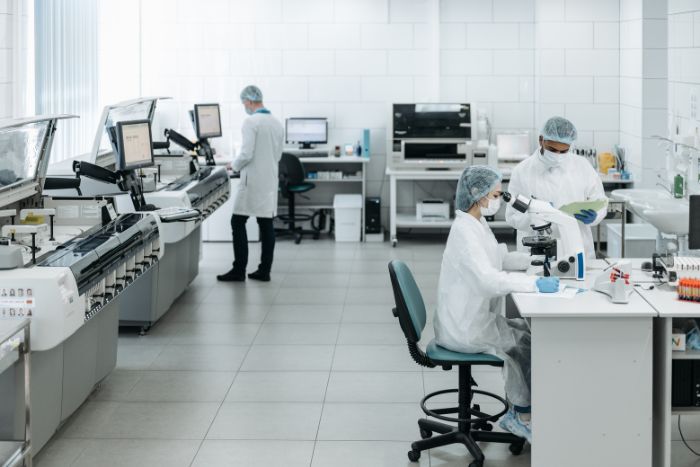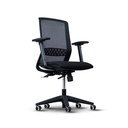The nature laboratory work requires regular repetitive movements, awkward postures and prolonged periods sitting and standing. Laboratory researchers are at risk of developing cumulative trauma injuries if they are not conscious of how they work. It is important for laboratory managers to create a healthy work environment for their team.
We need to educate staff on the risks associated with laboratory work. We also need to educate them on working positions, correct use of equipment and on good working habits to reduce the risk of work related injuries. In this article, we’re going to guide Laboratory Managers and Senior Medical Scientists on how to create a productive, health-focused work environment and culture within the lab.
Laboratory Ergonomics is about adapting the environment to the users requirements.
Ergonomics is the science of fitting the workstation and tools to fit the user in order to improve efficiency and to reduce musculoskeletal stresses leading to injury and illness. It incorporates a variety of areas including but not limited to environmental factors like workplace lighting, noise or temperature, the employee’s workstation setup and the employee’s physical well-being.
Although laboratories will vary in their investigative processes and their output, when it comes to ergonomics, common issues tend to arise. These continue to cause discomfort and injury to lab technicians and scientists alike.
A recent 10-year literature review (Pougnet et al 2017) on lab technicians found that when it came to Musculoskeletal Disorders (MSD) low back and neck were the most common areas for discomfort and pain.
Other research has indicated Repetitive Strain Injury (RSI) as a major contributor to pain among laboratory workers (Holm et al 2016). In medical and pharmaceutical labs, many tasks involve static postures and repetitive manual movements. This has the potential to trigger upper limb disorders like RSI.
Understand the space, then improve the space.
To implement ergonomic improvements, we need to first understand the work and the requirements of the people who use the space. This is generally done by doing an ergonomic assessment. There are four key areas we need to gain greater understanding in our ergonomic review of the laboratory:
- Understand how the tasks are performed in the area: Are the tasks repetitive? Do they require awkward postures? Is there a lot of twisting required? Etc.
- Understand the user requirements: What range of heights and different builds work in the laboratory? Are there complaints of back pain, neck pain etc.? Are people trained how to do their job? Does anybody have special requirements? Etc.
- Identify whether the environment and equipment are suitable for the task and the range of users who use the space: Is the equipment and lighting suitable for the task? Is there suitable space to perform the task safely? Do the chairs adequately support the user? Do people know how to use the equipment that they use safely? Etc.
- Review current lab processes to ensure ergonomic principles are carried across workstations, task design and the working environment.

You may do this review yourself or get help from health and safety or occupational health. Any review should make some improvements. If there are any complications in the space, ensure the person who does the assessment is suitably qualified to do the ergonomic laboratory review. You may need external ergonomic consultants in certain situations, but some improvements will be able to be made internally.
Start with Ergonomic Education and Training
Employee training and education on correct lab ergonomics is essential to prevent laboratory injuries. Lab technicians and scientists need a basic understanding of ergonomic principles in order to work safely but also efficiently. They need to be able to identify hazards and risk factors, understand how avoid them and how to manage their work area and their body to work comfortably.
The average work week equates to around 1/3 of your waking hours. Therefore, it is vital that people are safe and comfortable throughout their working day. Many laboratory workers sit for most of their working week. Couple this with a lengthy commute to and from work then add in TV and meal times. That’s a pretty sedentary week!
When it comes to those working in laboratories for hours on end, sitting safely is only one piece of the puzzle.
People may have good intentions when it comes to lab ergonomics. ‘Sit up straight’, ‘no slouching’, ‘careful picking that up’; the list goes on. Although good intentions count for something, understanding good ergonomics throughout the working day is needed to help ensure a lower risk of work-related injury. A reduced risk of injury means greater comfort which will allow for improved productivity in the lab.
Providing laboratory staff with education on correct setup is vital in ensuring a low risk of injury.

How to review the suitability of a seated laboratory workstation - 8 Key Tips
Each lab will have its own challenges based on the work environment, the tasks, the lab seating, the equipment and instruments used, and the range of user’s it accommodates. When it comes to desk setup the same principles apply to the different types of workstations.
1. Can all users sit with feet flat on the ground?
They need to be able to. This will reduce the likelihood of crossing legs under the chair. Often times in labs, high counter workstations mean this isn’t an option. In these cases, height adjustable footrests should be used to ensure the user is sitting into the chair in an upright posture. For high counter lab chairs there is usually a ring to allow the user to step up and sit safely.
Unfortunately, these rings are often misused as footrests. This can result in the back taking an unnatural ‘C’ shape as opposed to the desired elongated ‘S’ shape. A position like this will aggravate lower back discomfort and increase the likelihood of injury. To combat this, a height adjustable footrest is the best option. This forces the user to sit their bum all the way back into the chair and remain in an upright position while they work.
2. Does the workstation allow the user to sit with an open hip angle?
Set the height of the chair so the user’s hips are just above their knees. This will enable the individual to unload the pressure that would normally build up in their lower back.
3. Can the backrest angle be set to support the user in the position the task requires?
If the user isn’t supported by the chair, the backrest is providing no function. The chair’s back angle should be easily set to where the user will be comfortable while working.
If applicable use the recline mechanism on the chair to unload the lower back periodically. Postural variation is key to preventing the build-up of waste products in the lower back, in maintaining a healthy spine and in remaining comfortable.
4. For forward leaning work, does the chair support the user or allow them to open their hip angles?
Some tasks require the lab worker to lean forward, this shifts their centre of gravity forward and increases loading on the spine and the back and neck muscles.
If the task requires this working position, it is imperative that the chair either supports the forward leaning position which will help unload the spine. If this can’t be done, the chair must allow the user to open their hip angle, this will put the spine into a more balanced position and reduce the loading also.
5. Is the backrest height easily height adjustable so different users will adjust it throughout the day?
The backrest should be set where the main support is just above the waistband on your trousers. Different users will need to adjust it to their requirements, so it’s important that this is quick and easy to do.
This positioning will provide support to the lumbar region of the spine. Where discomfort can often be an issue.
6. Does the space allow items to be arranged to avoid unnecessary reaches and twisting by the user?
The space should allow items used most to be positioned nearest to the user eg. keyboard and mouse. (within in the optimum reach zone - half an arm’s length).
In some labs, items/equipment may vary but the same principle applies. This step will enable the user to avoid leaning over excessively and repeatedly twist, thus greatly reducing the likelihood of injuries like RSI. Items used less frequently can be placed slightly further away from the user (within the maximum reach zone – an arm’s length).
Again, the goal here is to prioritise the items used most by moving them closest to the user. For example, if a certain pipette is only used a couple of times each day there's no need to have it in the optimum reach zone.
7. Is there enough room for the monitor on the workstation?
Monitor Screen should be placed approximately arm’s length from you. This will help ensure the user doesn't develop any eye discomfort. Space is often an issue in laboratories, that is why monitor arms are good solutions as they raise the monitor above the workstation to save space and generally provide ease of adjustability
8. Can the monitor screens be easily adjusted in height to suit the range of users?
Screens that are not height adjustable tend to be a very common issue within labs. The top third of the screen should be at eye level. Research indicates the neck is a very high-risk area for pain among lab workers (Pougnet et al 2017).
This leads to constant neck flexion (forward head tilt) when using the computer, putting strain on the neck, shoulders and upper back. The monitor should be easily adjusted without any tools. Gas-assisted monitor arms will allow height, depth and angle adjustment that encourages a good working position and also flexibility required in laboratories.
This precaution will reduce the need to tilt the head to view the whole screen.
What working habits should I be encouraging in the laboratory?
“People do not decide their futures, they decide their habits and their habits decide their futures.”
― F. M. Alexander
Once set up correctly the focus should be on ensuring the user’s habits allow for continued safe working. Similar habits of concern re-emerge among lab workers. Getting a handle on why these issues occur will help to ensure they can be resolved and won’t lead to absenteeism or reduced productivity.
1. Advise people to reduce how regularly they lean forward.
Forward leaning at the workstation is extremely common within the lab environment due to the work that takes place. Employees need to be made aware of the additional strain this is placing on their body. To overcome this, advise users to sit as far back into the chair as possible and that they sit in as close to the workstation as possible.
A reason why they may not be sitting back into the chair is, maybe their feet can’t be firmly planted on the ground or on a height adjustable footrest as this will make it easier to maintain an upright posture in the chair. They shouldn’t be resting their feet on the footring (this is only for getting up and down from the chair) as this will encourage a forward leaning position. You may also need to advise people on where they position their items. They should move the items they’re interacting with, close to the edge of the workstation. This will limit the amount of reach needed.
2. Task Rotation
Due to the numerous repetitive motions required within the lab, RSIs are common. These injuries can be avoided by taking some precautions.
Design tasks that can be completed throughout the day instead of batching them. For example, instead of doing task ‘A’ till completion then starting and completing task ‘B’, rotate the tasks either with a time limit or number of units completed. A good rule is to rotate tasks every 20-30 minutes. This will allow different muscle groups to work within the different tasks, allowing the overworked muscles to rest.
For some tasks this may not be practical due to the nature of the work, but it should be practical to rotate staff between tasks every number of hours.
3. Encourage staff to take frequent micro breaks and stretch
During tasks that require long stints of repetitive work where no other task is performed then frequent micro breaks will help prevent discomfort or injury arising. Take pipetting for example.
One of the most common tasks performed in a lab setting. It involves stressors like thumb force, repetitive motions and tends to be done in awkward postures incorporating wrists, arms and shoulders. Advise laboratory workers to take micro breaks of 2-3 minutes every 25-30 minutes and implementing simple hand exercises and stretches. Developing this habit over time will ensure minimal risk of injury.
4. Advise staff to adjust workstations before the start of a prolonged period of work
Generally, lab work will have some element of task rotation. This means that users will be moving between workstations regularly. Everybody is built differently, so they have different requirements. Some lab workstations will have a set up incorporating a high counter, a high chair, a footrest and a computer screen. Consciously taking a minute to set up the workstation prior to beginning a task will ensure continued productivity and reduce any risk of discomfort.
Points to note:
- Ergonomic solutions that are easily adjusted will make it easier for users to change workstations seamlessly without taking away from their work.
- Ergonomic workshops are a great idea to ensure all workers are aware of how to set themselves up at different types of workstations.
How you can start making ergonomic improvements in your lab?
1. Training or Workshops
All lab-based employees should receive training or attend a workshop for all tasks that their job involves. Responsibilities should be given to more senior members of staff to ensure a high standard of ergonomics is maintained following training.
Specific attention should be given to new starts also to make sure they have a good ergonomic foundation. The workshops should cover general safe working habits for laboratory workers and how to use the equipment.
2. Ergonomic Reminders
In line with the saying ‘Out of sight out of mind’ the principles and practices of good ergonomics should be put up where employees can see as cues to help them develop positive habits. Posters in common areas can be helpful or periodic email reminders.
3. Training on New Instruments/ Equipment
If you purchase new equipment, they are likely to have some new features. If the staff are unfamiliar with new tools or equipment, then training again should be encouraged to prevent any ergonomic issues arising.
4. Gradual Improvements
Once education on setup and habits is up to date, focus should be applied to improve the ergonomic processes by first targeting the higher risk areas. Look for and encourage feedback from colleagues. If you are not aware of problems, you can’t solve them, and they can worsen. To begin, identify any workers with discomfort by conducting ergonomic assessments. Follow this up with an ergonomic review of the lab. The results from these will enable relevant personnel to resolve ergonomic issues for those in pain or discomfort.
Once higher risk issues are resolved move towards medium risk. This incorporates all issues that the lab review suggests could lead to injury. Finish up with the lower risk recommendations which will ensure minimal risk of injury while improving user comfort and productivity.
Working towards continuous improvement
If the work environment is designed around the employees’ requirements and employees’ genuine issues are listened to and acted upon, then employees will be more comfortable and happier at work. If somebody is uncomfortable or in pain, they are not going to focus on their work and their productivity will be reduced. By understanding the tasks, the user and the environmental requirements or challenges a tailored approach to resolving issues can be taken. Small regular, focused changes in the right direction will make a big difference to creating a functional and happy laboratory.
References;
Pougnet, R., Loddé, B., Uguen, M., Sawicki, B. and Pougnet, L., 2017, November. Medical laboratory technician professional pathologies: a 2006-2016 literature review. In Annales de biologie clinique (Vol. 75, No. 6, pp. 664-672)
Holm, J.W., Mortensen, O.S. and Gyntelberg, F., 2016. Upper limb disorders among biomedical laboratory workers using pipettes. Cogent Medicine, 3(1), p.1256849
De Beeck, R.O. and Hermans, V., 2000. work-related low back disorders. Bilbao, Spain.
Loisel, P., Gosselin, L., Durand, P., Lemaire, J., Poitras, S. and Abenhaim, L., 2001. Implementation of a participatory ergonomics program in the rehabilitation of workers suffering from subacute back pain. Applied ergonomics, 32(1), pp.53-60















